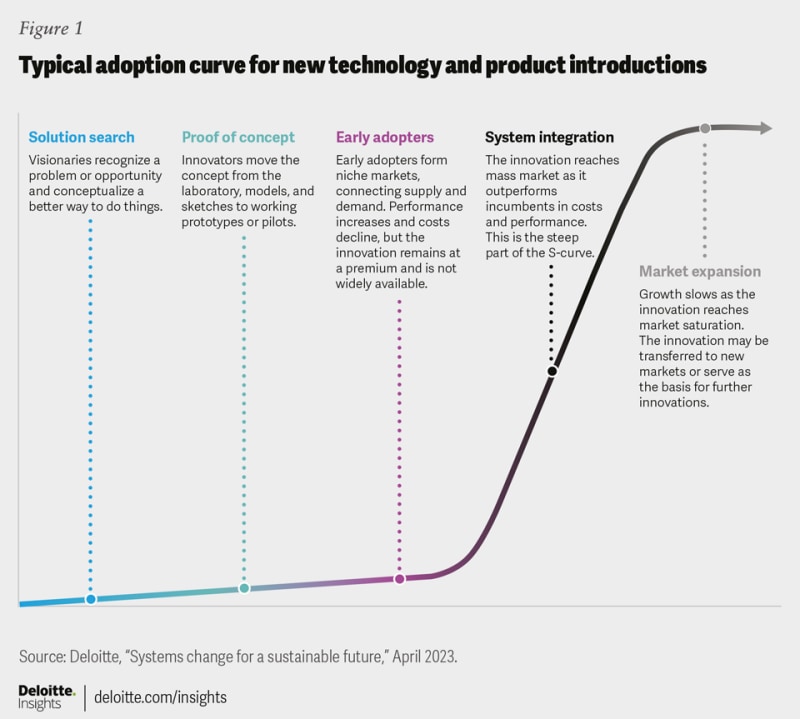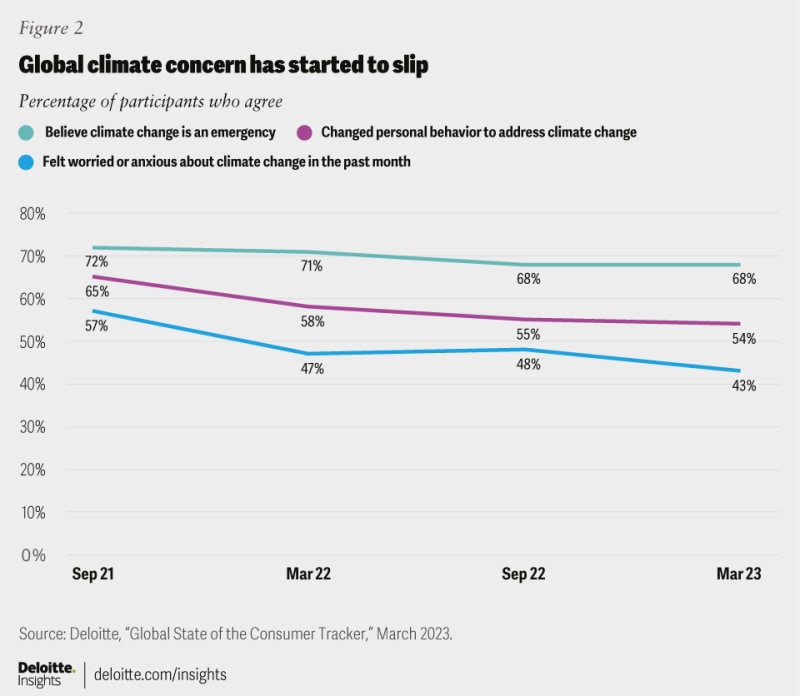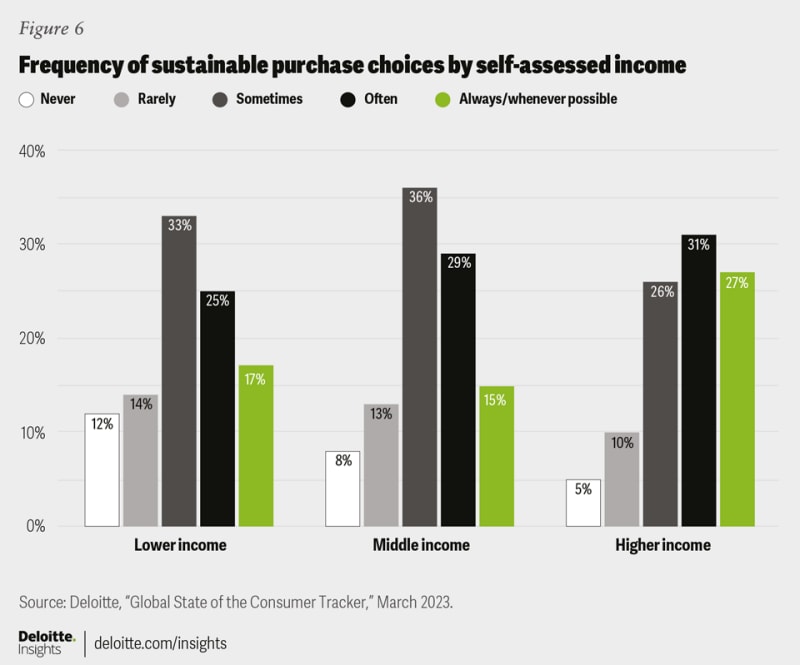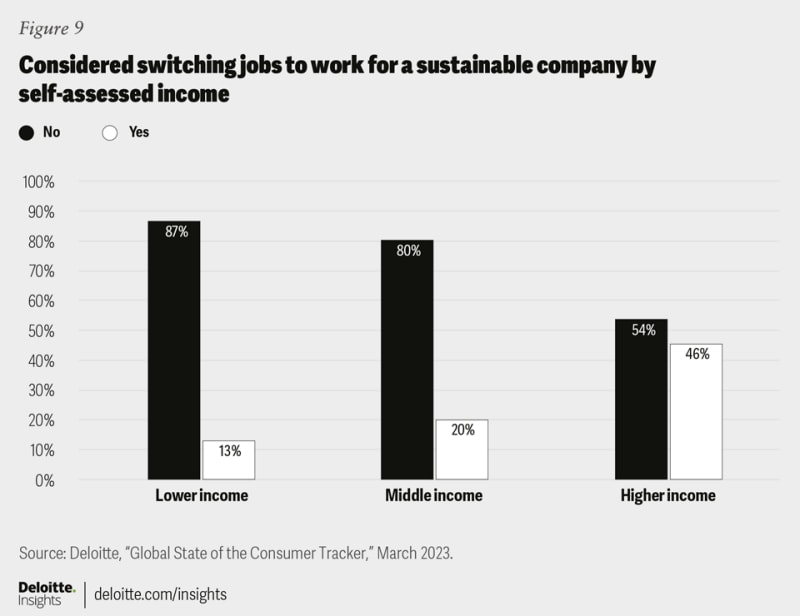Enabling sustainable actions for all
Divergences in climate action and sustainable behavior go beyond having the financial means to purchase an EV or local, organic produce. They also suggest deeper, structural issues. Those with lower incomes may not have the opportunity to advocate for climate action in their workplace in the same way that a wealthier person might. Or they might not have the same access to the political process. Academic research has consistently found that those with higher incomes tend to vote more often, attend more campaign events, and donate more to politicians.32 Given these barriers, it suggests there may be a “ceiling” for lower-income individuals’ ability to undertake some of the actions discussed here. And it may also suggest we should be cautious about the ways in which those with means affect climate and sustainability outcomes. Without opportunities and meaningful participation from across the socioeconomic spectrum, simply encouraging those with higher incomes to “do more” could risk entrenching existing systemic biases and inequalities, likely making the goals of climate equity and a just transition to a low-carbon economy even more difficult to achieve. Whether formulating a corporate net-zero plan or engaging in international negotiations, helping ensure climate discussions consider all voices with representation across socioeconomic, race, gender, and other dimensions, is critical.
To that end, organizations have an opportunity to make sustainable choices more available to everyone, regardless of socioeconomic status or current financial situation.
Companies, especially those with large numbers of workers across a variety of income levels, should test whether their sustainability efforts are reaching all employees. Companies can help ensure education and training programs are available to every worker and create channels through which employees can raise concerns and ideas for how to operate more sustainably.
Doing so proactively can help address a leading source of pressure, possibly improve morale and retention, and make companies a more attractive target for talent. More than half of C-suite executives surveyed by Deloitte in 2022 said employee activism on climate matters has led their organizations to increase sustainability actions over the last year—and 24% of those respondents said employee activism led to a “significant” increase.33 Forty-two percent cited employee morale and well-being as a leading benefit of their companies’ sustainability efforts.
Consumer-facing companies can aim to scale sustainable goods and services to the point where they are the first choices based on their quality and price. Given the potential for price sensitivity, companies may have to innovate to bring the overall costs down continually.34 They might also consider ways to tweak pricing such that conventional—and potentially more polluting—products wear a higher price tag.
Consider, for example, the development of EVs, which carried a significant price premium for many years and leading models were targeted firmly at higher-end buyers. In the United States, for example, most EV owners’ household income exceeded US$100,000 as of 2020.35 But thanks in part to those early adopters’ willingness to pay extra, battery prices (the most significant contributor to EVs’ cost) have plummeted, falling almost 90% between 2010 and 2021.36 The result: EVs recently reached 5% penetration in the United States, joining other markets in reaching a critical tipping point beyond which adoption often accelerates.37 Many forward-thinking companies are working to put other product categories on the same trajectories by innovating green technologies and installing infrastructure.38
Perhaps, more challenging consumer companies might work to associate affluence with simply consuming less. Such an approach may appear to clash with existing business models, but several companies are already voicing that iconoclastic message.39 But it comes with potential benefits for companies, including brand loyalty and differentiation, especially among younger buyers. Thirty-seven percent of millennials and 33% of Generation Z respondents in a separate Deloitte survey say they already avoid buying fast fashion, and about 80% of respondents say they want business to do more to enable consumers to make more sustainable purchasing decisions.40
Finally, governments have numerous policy tools they can consider. While political realities vary widely across the globe, leaders can be attuned to how policies differentially affect different income levels. For example, carbon taxes can be regressive41—although needn’t be if revenue is redistributed, as in Canada.42 Many governments are targeting subsidies and credits in such a way as to make green products more accessible to lower-income households. For example, some home electrification and EV rebates in the recent US Inflation Reduction Act are calibrated against household income.43
Conclusion
There is a paradox at the heart of addressing climate change. Systems-level changes to the ways we produce energy, move people and goods, grow and consume food, and make things are key.44 In that context, any individual’s action is like a grain of sand on a beach.
But at the same time, people are the ones who can act. Change won’t come, or won’t come fast enough, without the collective impetus of millions making new choices and working to help ensure that tackling climate change is on the agenda of companies and governments.
Organizations that want to address climate change without considering fairness and equity are likely missing out on important ideas and risk building their climate efforts on a shaky foundation. But climate action and equity can also positively reinforce one another.45 Companies and governments can play an important role in enabling those they impact—whether customers, workers, or constituents—to have the opportunity to take action for a sustainable future.




















.png/_jcr_content/renditions/cq5dam.web.700.366.jpeg)





